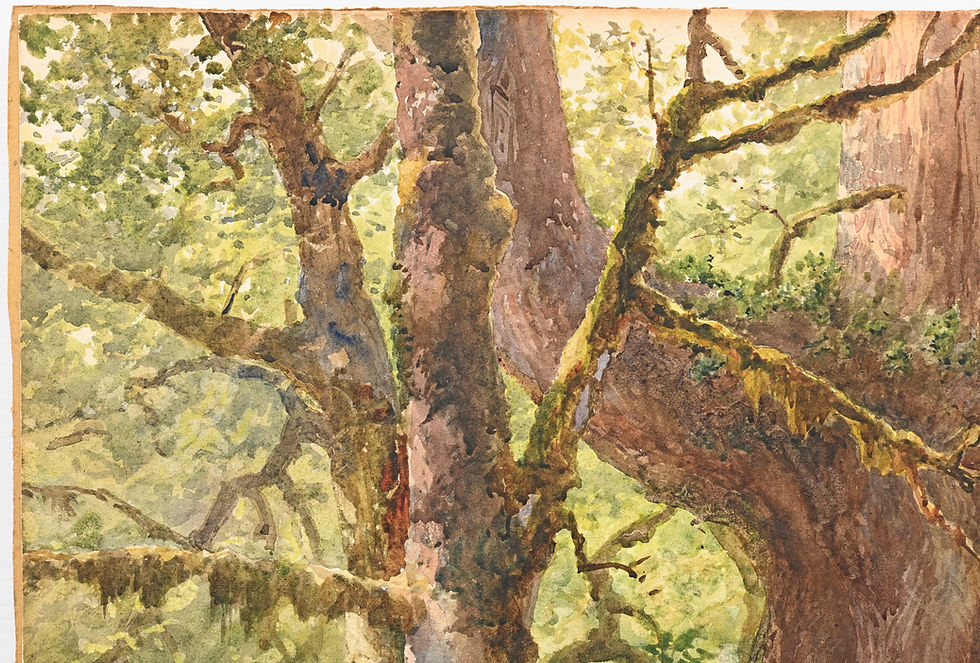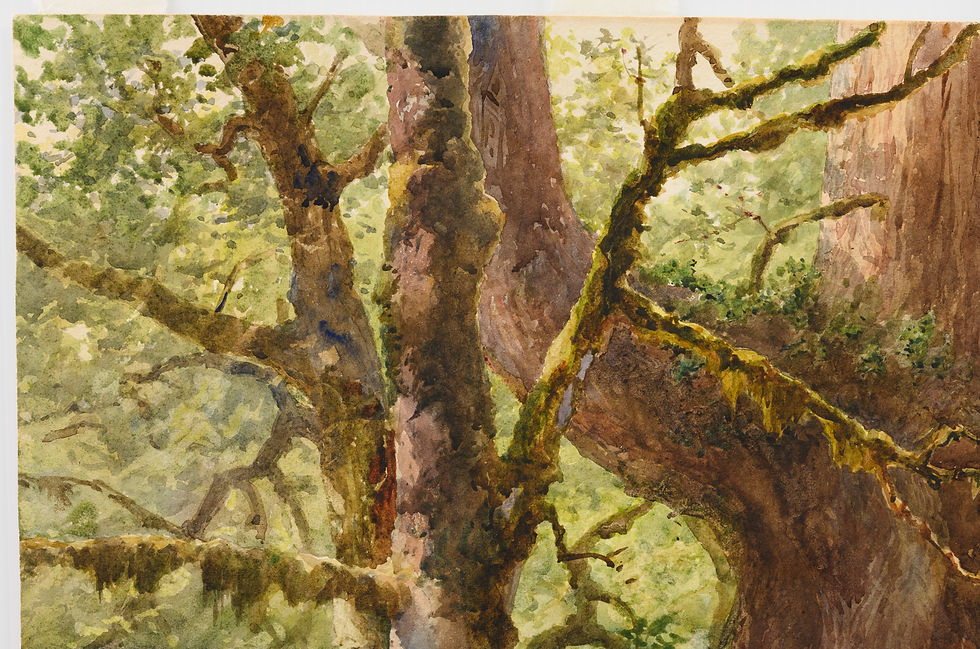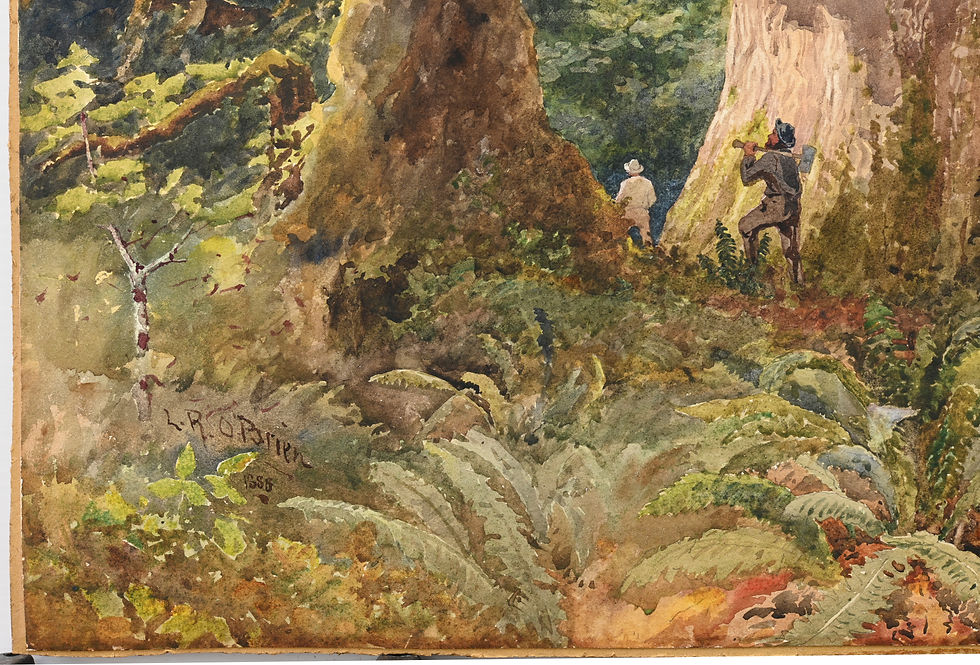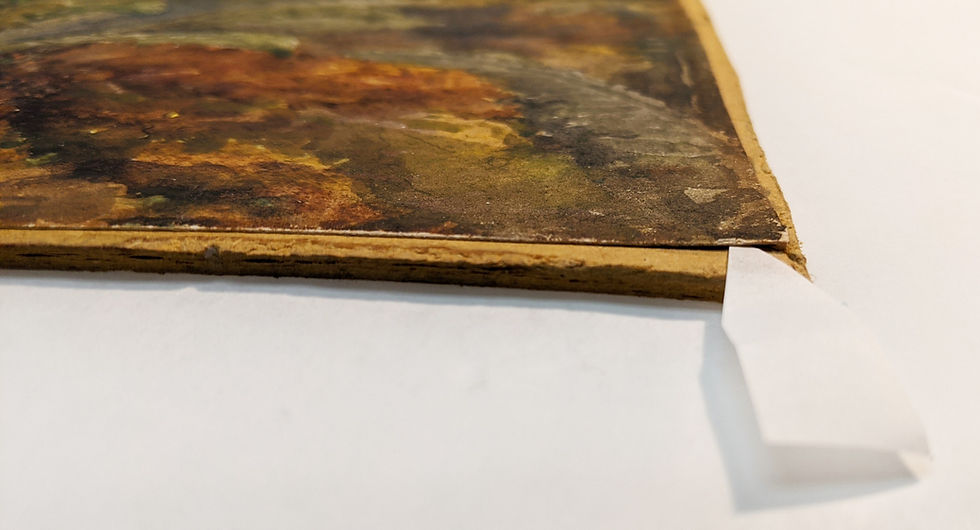Lucius O’Brien
- juliet graham
- Feb 25, 2022
- 4 min read
Updated: Mar 10, 2022

When grant money from the federal government became available to ULAG for conservation treatment of collection artworks through the Museums Assistance Program in the fall of 2019, ULAG staff had to decide quickly what works from our collection were in need of conservation treatment, and which works would both benefit from treatment and benefit the collection: meaning, which works were both popular and meaningful to our gallery’s visitors. This is the story of one of the works that fit the bill: Lucius O’Brien’s Giant Cedar Glade in a BC Forest, painted in 1888, and pictured at left.
This beloved painting from the ULAG collection was a perfect candidate: it has been shown frequently and is frequently in demand for class and other tours. As well, Lucius O’Brien was an important artist in Canadian art history, a person who brought energy and optimism to Canada’s artists at a time when Canada was establishing itself as a country. The Royal Canadian Academy, of which O’Brien was the first president, was the first of many groups of artists that worked together to promote artmaking in Canada, the RCA also providing the base of the collection of the new National Gallery of Canada, which began its collection from works made by these new RCA members. This work is an important part of the story of Canada and an important work in the ULAG collection.
As for getting this artwork to the paper conservator's studio, the clock was already ticking: the conservation grant money came into our hands in October of that year, and needed to be spent by the following March of 2020. At the time gallery staff had been working from home due to the pandemic since the previous March. Our art gallery team pulled together to make this project happen in a very short time window with the help of some very talented conservators.
I prepared a condition report to send to the conservator. A condition report is sort of a wellness check using descriptive language and detailed photographs to outline the “condition” of the “patient” aka the artwork. As registrar at ULAG and formerly a paper conservator for 10 years I have written hundreds of these reports for different art objects; this report in particular needed to be read and understood well by the conservator, Tara Fraser, who would be doing the work could make an accurate cost estimate before actually seeing the work with her own eyes.

To prepare the condition report before the artwork left ULAG, it was unframed to examine the work thoroughly.
The painting was done on watercolour paper, and then glued all over to a support board. In this detail at left you can see the medium-brown coloured support board peeking out at the very edges of the painting. This support board had been in place for many years; ULAG acquired this work in 1988, and at that time it had already been in this frame for many years .
Although the painting itself is on good quality paper, the support board was not good quality, and its poor quality materials were migrating from the backing board into the watercolor paper. The backing board was a mat
board that contained impurities known generally as “acidic materials” which cause the board to discolour and become brittle over time. This embrittlement can sometimes result in a backing board snapping into pieces, and if an artwork is glued down to it, the artwork might snap right along with the board.

This detail image of the top edge of the painting shows the brown backing board that the painting sits on, and in the image at right you can really see the acidic discolouration that is transferring to the watercolour paper at the top edge where the sky is behind the tree’s leaves.

At right is the same area after conservation treatment looking much cleaner and brighter.


These 2 details of the bottom edge of the painting show the acidic, discoloured backing board as well as well as some “tide lines” on the backing board which are indications of liquid that has dried, fortunately only affecting the backing board and not the painting itself. A triangle of white paper shows that the painting is not completely adhered to the backing board and is lifting ever so slightly in this area. This would let the conservator know that there would be an opportunity to test the adhesive holding the watercolour in place.
When Giant Cedar arrived at Fraser Spafford-Ricci Art and Archival Conservation Inc. it was again thoroughly examined and spot tests were performed on the work, and then the conservation team set to work to clean the painting’s surface and remove the acidic backing board. Testing indicated that the adhesive used to hold that painting to the backing board was water soluble.

This image shows a member of the conservation team working on the artwork from behind removing the brown, acidic backing board to reveal the good quality watercolour paper beneath. The black shapes in front of the conservator’s hands are weights that hold the work firmly in place so that as the backing is delaminated and peeled away the work does not shift and cause abrasion to the painted surface face-down on the table.
Once only remnants remained adhered to the watercolour itself, moisture was applied and it was possible to lift the remaining bits of the acidic board. The work was then washed to remove any soluble adhesive dirt, grime or acidic materials leaving the paper brighter and more like its original colour, the brittleness that had transferred from the old backing board lessened as the acidity was washed away and the paper regained a more neutral overall pH. The work was then dried and flattened under slight pressure to restore its planar quality.
Giant Cedar was then reframed in its original frame with museum quality matboards and materials used inside the frame.
Back at the U of L Art Gallery, safe and sound, it is ready to be shown again.

Lucius O'Brien, Canadian 1832 - 1899 Giant Cedar Glade in a B.C. Forest, 1883, watercolour on paper. From the University of Lethbridge art collection, purchased 1988 with funds provided by the Alberta Advanced Education Endowment and Incentive Fund



Comments